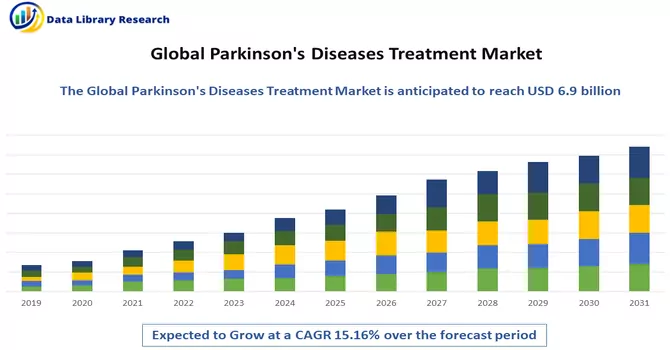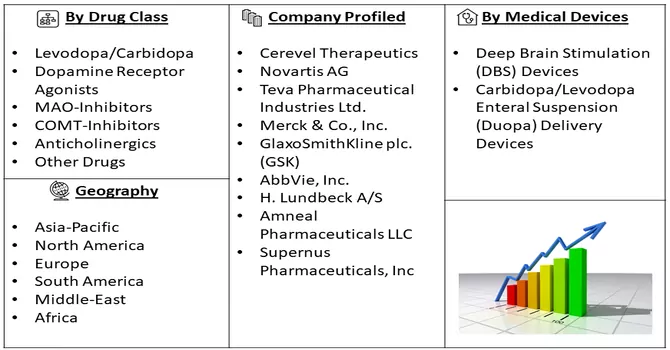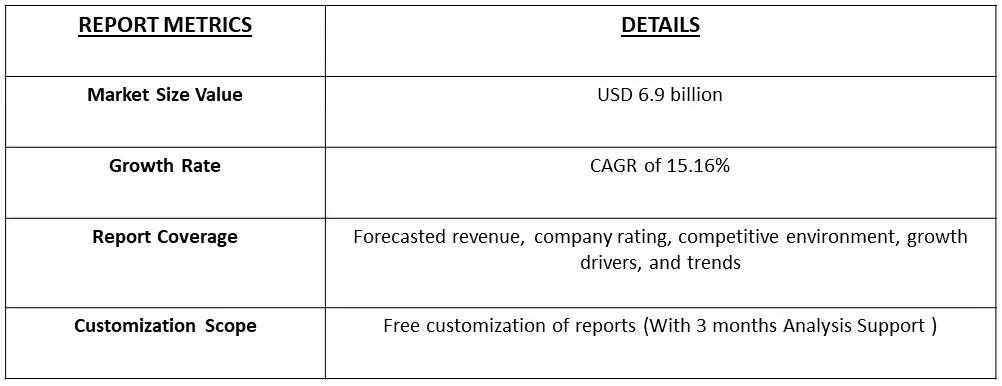The global Parkinson’s disease treatment market size was valued at USD 6.9 billion in 2023 and is expected to expand at a compound annual growth rate (CAGR) of 15.16% from 2024 to 2030.

Get Complete Analysis Of The Report - Download Free Sample PDF
Parkinson's disease treatment involves a comprehensive approach to manage symptoms and enhance the quality of life for those affected. Medications such as levodopa, dopamine agonists, and MAO-B inhibitors are commonly prescribed to address specific symptoms. Surgical interventions, like Deep Brain Stimulation (DBS), can be considered for advanced cases. Physical therapy, occupational therapy, and speech therapy play crucial roles in improving mobility, independence, and communication skills. Incorporating regular exercise, dietary adjustments, and lifestyle modifications contribute to overall well-being. Additionally, supportive and psychosocial therapies, including support groups and counselling, address emotional and psychological aspects. The individualized treatment plan, developed in collaboration with a healthcare team, aims to provide holistic care and support for both individuals with Parkinson's disease and their caregivers. While there is currently no cure, these interventions help manage symptoms and enhance the overall quality of life throughout the progression of the disease.
The Parkinson's disease treatment market is propelled by various driving factors, including the global ageing population, which correlates with an increased incidence of Parkinson's disease. Ongoing advancements in medical research and neuroscience, unravelling the disease's underlying mechanisms, lead to innovative therapeutic approaches. Growing awareness among patients and healthcare professionals, coupled with technological innovations such as wearable devices and telemedicine, fosters early diagnosis and management. Government initiatives, substantial healthcare expenditure, and collaborations between pharmaceutical companies and research institutions contribute to the development and commercialization of novel treatments. Patient advocacy groups and the globalization of clinical trials further enhance the overall environment for Parkinson's disease research and market expansion. This amalgamation of factors creates a dynamic landscape, presenting opportunities for pharmaceutical companies, healthcare providers, and researchers to meet the evolving needs of Parkinson's disease patients.
Market Segmentation: The Global Parkinson’s Disease Treatment Market, is Segmented By Drug Class (Levodopa/Carbidopa, Dopamine Receptor Agonists, MAO-Inhibitors, COMT-Inhibitors, Anticholinergics, Other Drugs), Medical Devices (Deep Brain Stimulation (DBS) Devices, Carbidopa/Levodopa Enteral Suspension (Duopa) Delivery Devices), and Geography (North America, Europe, Asia-Pacific, Middle East & Africa, and Latin America). The market provides the value (in USD million) for the above-mentioned segments.

For Detailed Market Segmentation - Download Free Sample PDF
The Parkinson's disease treatment market is witnessing notable trends that shape its trajectory. Personalized medicine is emerging as a significant trend, with a focus on tailoring treatments to individual patients based on genetic, molecular, and clinical characteristics. Technological integration, including the incorporation of artificial intelligence and wearable devices for remote patient monitoring, is enhancing disease management and improving treatment outcomes. The rise of disease-modifying therapies is gaining momentum, with a shift from solely symptom management to interventions that potentially alter the course of the disease. Moreover, an increasing emphasis on holistic care, encompassing not only pharmacological interventions but also physical therapy, exercise regimens, and lifestyle modifications, reflects a comprehensive approach to Parkinson's disease treatment. Collaboration and partnerships between pharmaceutical companies and research institutions are fostering innovation, while a growing interest in regenerative medicine and gene therapies holds promise for novel and groundbreaking treatment modalities. As the market continues to evolve, these trends collectively contribute to a more patient-centric, technologically advanced, and diversified landscape for Parkinson's disease treatment options.
Market Drivers:
Advancements in Drug Development
Advancements in drug development for Parkinson's disease have marked a promising era in addressing the complex and progressive nature of this neurodegenerative disorder. Researchers and pharmaceutical companies are continually exploring innovative approaches to enhance treatment efficacy and improve the quality of life for individuals affected by Parkinson's disease. One notable focus lies in the development of disease-modifying therapies that target underlying mechanisms, such as alpha-synuclein aggregation and leucine-rich repeat kinase 2 (LRRK2) abnormalities, which are implicated in the pathogenesis of Parkinson's disease. Novel drug candidates, including alpha-synuclein targeting antibodies, gene therapies, and small molecule inhibitors of specific kinases, have entered clinical trials, reflecting a paradigm shift from solely managing symptoms to potentially altering the disease course. The exploration of personalized medicine and biomarkers has gained momentum, allowing for tailored treatment approaches based on individual patient characteristics. Furthermore, advancements in drug delivery mechanisms aim to enhance treatment precision and reduce side effects. Nanotechnology and innovative formulations offer the potential for targeted drug delivery to specific regions of the brain, optimizing therapeutic outcomes. Continuous infusion systems and wearable devices also play a role in improving medication adherence and management of motor fluctuations. Collaborations between pharmaceutical companies, academic institutions, and research organizations have become pivotal in driving drug development initiatives. Partnerships facilitate the pooling of resources, expertise, and data, accelerating the translation of scientific discoveries into viable therapeutic options. Additionally, advancements in artificial intelligence and machine learning contribute to the identification of novel drug targets and the optimization of clinical trial designs. Thus, such factors are expected to drive the growth of the studied market over the forecast period.
Increasing Healthcare Expenditure
The surge in global healthcare expenditure is significantly shaping the landscape of Parkinson's disease treatment. This financial boost is fostering research, development, and the provision of advanced therapies, expanding the accessibility of cutting-edge treatments for individuals affected by Parkinson's. The increased funding supports clinical trials, enabling the evaluation of innovative treatment modalities and the translation of scientific discoveries into practical solutions. Additionally, the rising healthcare expenditure encourages the adoption of advanced technologies and personalized medicine, offering more targeted interventions and improving overall patient outcomes. While these advancements bring hope for enhanced Parkinson's disease management, careful consideration is needed to ensure equitable access to treatments and the sustainable integration of innovative approaches within healthcare systems worldwide. Overall, the escalating healthcare expenditure holds the potential to usher in a transformative era of improved care and treatment outcomes for those living with Parkinson's disease.
Market Restraints:
High Cost of Treatment
The high cost of treatment stands as a potential impediment to the growth of the Parkinson's disease treatment market. As innovative therapies and advanced medications continue to emerge, the associated expenses for both research and development and the subsequent production can result in elevated treatment costs. This financial burden may limit the accessibility of these cutting-edge treatments for a significant portion of the patient population, potentially hindering widespread adoption. Additionally, the high costs of therapy may place strains on healthcare budgets, impacting reimbursement policies and affordability for patients. This economic barrier could, in turn, slow down the market growth, creating challenges in achieving optimal patient outcomes and equitable access to innovative Parkinson's disease treatments. Balancing the imperative for research investment and technological advancements with the need for affordability and accessibility remains a critical challenge in ensuring sustainable growth and inclusivity in the Parkinson's disease treatment market. Efforts to address cost-related barriers through strategic pricing, reimbursement models, and collaborative partnerships are essential for navigating this complex landscape and promoting a more accessible and sustainable future for Parkinson's disease treatment.
The COVID-19 pandemic has exerted a multifaceted impact on the Parkinson's disease treatment market, presenting both challenges and opportunities. On one hand, disruptions in healthcare services, lockdowns, and limitations on non-essential medical procedures have led to delays in diagnosis and treatment initiation for Parkinson's patients. These delays may contribute to an increased disease burden and worsened symptoms. On the other hand, the pandemic has accelerated the adoption of telemedicine and digital health solutions, providing avenues for remote monitoring and consultation, thereby ensuring continuity of care for individuals with Parkinson's disease. The pharmaceutical supply chain has faced challenges, affecting the availability and distribution of medications, albeit to varying degrees. Additionally, the economic repercussions of the pandemic have influenced healthcare budgets and patient affordability, impacting the accessibility of treatment options. Despite these challenges, the global focus on health and research has heightened, potentially leading to increased investments in Parkinson's disease research and the development of innovative therapies. The long-term consequences of the pandemic on the Parkinson's disease treatment market will likely unfold as healthcare systems adapt to the evolving landscape and capitalize on the lessons learned during this unprecedented global health crisis.
Segmental analysis:
Levodopa/Carbidopa Segment is Expected to Witness Significant Growth Over the Forecast Period
Levodopa/Carbidopa, often referred to as the gold standard in Parkinson's disease treatment, represents a cornerstone in managing the symptoms of this neurodegenerative disorder. This combination medication consists of levodopa, a precursor to dopamine, and carbidopa, which prevents the peripheral conversion of levodopa into dopamine before it reaches the brain. By increasing dopamine levels in the brain, Levodopa/Carbidopa effectively alleviates motor symptoms such as tremors, stiffness, and bradykinesia, providing substantial relief to individuals with Parkinson's disease. The therapeutic benefits of Levodopa/Carbidopa, however, come with considerations. Prolonged use can lead to motor complications such as dyskinesias and motor fluctuations, challenging the long-term management of the disease. Additionally, the optimal dosage and timing of administration require careful calibration to balance the effectiveness of symptom control and minimize side effects. Despite these challenges, Levodopa/Carbidopa remains a pivotal medication in Parkinson's treatment, often prescribed in various formulations, including immediate-release and controlled-release forms, to cater to individual patient needs. Its widespread use underscores its efficacy in improving the quality of life for those living with Parkinson's disease. As research advances, efforts continue to enhance Levodopa/Carbidopa's therapeutic profile and mitigate long-term complications, contributing to its enduring role in the comprehensive management of Parkinson's disease.
Deep Brain Stimulation (DBS) Devices Segment is Expected to Witness Significant Growth Over the Forecast Period
Deep Brain Stimulation (DBS) devices have emerged as a transformative intervention in the treatment of Parkinson's disease. This surgical approach involves implanting electrodes into specific regions of the brain, typically the subthalamic nucleus or globus pallidus, which are then connected to a neurostimulator device similar to a pacemaker. DBS operates by delivering controlled electrical impulses to modulate abnormal neural activity, effectively alleviating motor symptoms associated with Parkinson's disease, such as tremors, bradykinesia, and rigidity. One of the significant advantages of DBS is its ability to provide substantial symptomatic relief for individuals who may not respond optimally to medication alone or who experience medication-related side effects. Moreover, DBS allows for adjustments in stimulation parameters, providing a personalized and adaptable treatment approach to cater to individual patient needs. While DBS has proven efficacy in managing motor symptoms, its exact mechanisms of action are not entirely understood. Ongoing research aims to unravel the nuanced impact of DBS on neural circuits, contributing to refinements in the technique and potential applications for a broader range of neurological conditions. Despite its success, DBS is not a cure for Parkinson's disease, and careful patient selection, thorough evaluation, and post-operative management are crucial for optimal outcomes. As technology advances, there are continuous improvements in the design and functionality of DBS devices, including miniaturization, longer battery life, and enhanced programming capabilities.The integration of DBS into Parkinson's disease treatment protocols highlights the evolving landscape of neurostimulation therapies. As research progresses, there is optimism that DBS, in combination with other therapeutic modalities, will continue to play a pivotal role in enhancing the quality of life for individuals living with Parkinson's disease.
North America Region is Expected to Witness Significant Growth Over the Forecast Period
North America stands at the forefront of Parkinson's disease research, treatment, and support, playing a pivotal role in addressing the challenges and opportunities associated with this neurodegenerative disorder. The region boasts advanced healthcare infrastructure, a robust pharmaceutical industry, and cutting-edge research facilities, contributing to the development and dissemination of innovative therapies and interventions for Parkinson's disease. In North America, numerous healthcare institutions and research centers actively engage in clinical trials, investigating novel treatments, disease-modifying approaches, and potential breakthroughs in understanding the underlying mechanisms of Parkinson's. The collaborative efforts of academic institutions, pharmaceutical companies, and healthcare organizations foster an environment conducive to advancements in the field. The region's commitment to Parkinson's research is complemented by a strong advocacy and support network. Patient advocacy groups, foundations, and non-profit organizations in North America actively work towards raising awareness, providing resources, and supporting individuals and families affected by Parkinson's disease. These initiatives contribute to a more informed and engaged community, fostering dialogue and collaboration among patients, caregivers, researchers, and healthcare professionals. Moreover, North America has been a significant market for Parkinson's disease treatments, witnessing the adoption of state-of-the-art therapies, medications, and technologies. The healthcare systems in countries such as the United States and Canada emphasize comprehensive care, incorporating a multidisciplinary approach to address the diverse needs of Parkinson's patients. Despite these advancements, challenges persist, including healthcare disparities, access to treatment, and the impact of socio-economic factors on patient outcomes. Efforts are ongoing to address these challenges through policy initiatives, community outreach, and research programs. In summary, North America plays a pivotal role in the landscape of Parkinson's disease, serving as a hub for research, treatment innovation, and support networks. The region's commitment to advancing scientific understanding and improving patient care underscores its crucial role in the global effort to confront and manage Parkinson's disease.

Get Complete Analysis Of The Report - Download Free Sample PDF
Prominent industry participants are strategically leveraging tactics like mergers and acquisitions, as well as collaborative ventures, to not only expand their presence on a regional scale but also to enhance their market share significantly. These strategic maneuvers underscore a concerted effort among major players to capitalize on synergies, strengthen their competitive positions, and tap into new opportunities within the market. By engaging in such strategic initiatives, these key players aim to fortify their market presence, foster innovation, and establish formidable partnerships that can contribute to sustained growth and leadership in their respective domains. Some of the prominent players in the global Parkinson’s disease treatment market include
Recent Development:
1) In June 2022, a collaboration was established between Biogen Inc. and Alectos Therapeutics, wherein they entered into an agreement to jointly develop and market GBA2 inhibitors, specifically AL01811, as a potential therapeutic solution for individuals afflicted by Parkinson's disease. Under this agreement, Biogen secured exclusive rights for the global development, manufacturing, and commercialization of AL01811, marking a strategic partnership aimed at advancing the treatment options available for patients suffering from Parkinson's disease.
2) Biogen revealed in June 2021 the successful finalization of the acquisition of TMS-007, a Phase 2-ready asset designed for addressing Parkinson's disease. TMS-007 functions as a small molecule inhibitor targeting the leucine-rich repeat kinase 2 (LRRK2) protein, a key player believed to be involved in the progression of Parkinson's disease. This acquisition underscores Biogen's strategic move to bolster its portfolio and advance potential therapies aimed at addressing the complexities of Parkinson's disease.
Q1. What was the Parkinson's Diseases Treatment Market size in 2023?
As per Data Library Research the global Parkinson’s disease treatment market size was valued at USD 6.9 billion in 2023.
Q2. At what CAGR is the Parkinson’s disease treatment market market projected to grow within the forecast period?
Parkinson’s disease treatment market is expected to expand at a compound annual growth rate (CAGR) of 15.16% over the forecast period.
Q3. What are the factors driving the Parkinson’s disease treatment market?
Key factors that are driving the growth include the Advancements in Drug Development and Increasing Healthcare Expenditure.
Q4. Which region has the largest share of the Parkinson’s disease treatment market? What are the largest region's market size and growth rate?
North America has the largest share of the market. For detailed insights on the largest region's market size and growth rate request a sample here.
Data Library Research are conducted by industry experts who offer insight on industry structure, market segmentations technology assessment and competitive landscape (CL), and penetration, as well as on emerging trends. Their analysis is based on primary interviews (~ 80%) and secondary research (~ 20%) as well as years of professional expertise in their respective industries. Adding to this, by analysing historical trends and current market positions, our analysts predict where the market will be headed for the next five years. Furthermore, the varying trends of segment & categories geographically presented are also studied and the estimated based on the primary & secondary research.
In this particular report from the supply side Data Library Research has conducted primary surveys (interviews) with the key level executives (VP, CEO’s, Marketing Director, Business Development Manager and SOFT) of the companies that active & prominent as well as the midsized organization
FIGURE 1: DLR RESEARH PROCESS

Extensive primary research was conducted to gain a deeper insight of the market and industry performance. The analysis is based on both primary and secondary research as well as years of professional expertise in the respective industries.
In addition to analysing current and historical trends, our analysts predict where the market is headed over the next five years.
It varies by segment for these categories geographically presented in the list of market tables. Speaking about this particular report we have conducted primary surveys (interviews) with the key level executives (VP, CEO’s, Marketing Director, Business Development Manager and many more) of the major players active in the market.
Secondary ResearchSecondary research was mainly used to collect and identify information useful for the extensive, technical, market-oriented, and Friend’s study of the Global Extra Neutral Alcohol. It was also used to obtain key information about major players, market classification and segmentation according to the industry trends, geographical markets, and developments related to the market and technology perspectives. For this study, analysts have gathered information from various credible sources, such as annual reports, sec filings, journals, white papers, SOFT presentations, and company web sites.
Market Size EstimationBoth, top-down and bottom-up approaches were used to estimate and validate the size of the Global market and to estimate the size of various other dependent submarkets in the overall Extra Neutral Alcohol. The key players in the market were identified through secondary research and their market contributions in the respective geographies were determined through primary and secondary research.
Forecast Model
